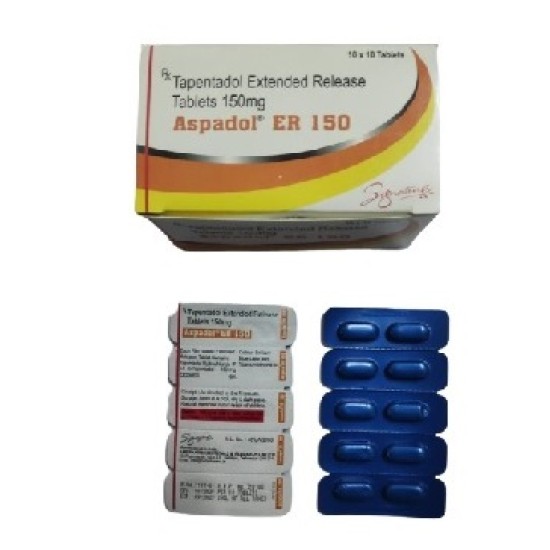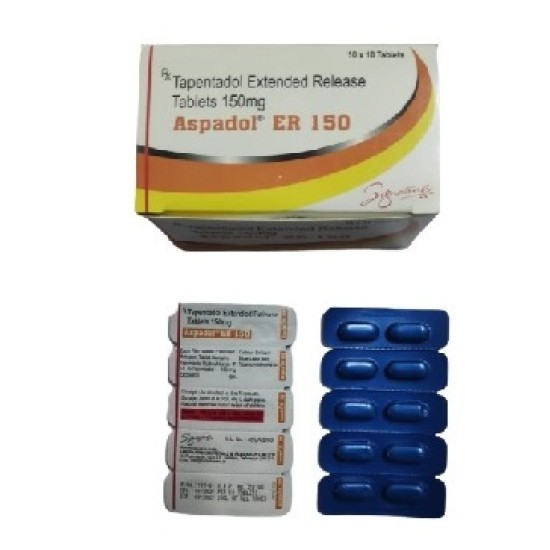
Aspadol 150 mg is a potent painkiller that doctors prescribe in specific situations. It is not a first-line treatment and should only be used under medical supervision. Below are common scenarios where Aspadol 150mg becomes an appropriate option.
1. Chronic Musculoskeletal Pain
Aspadol effectively treats chronic pain in conditions like:
-
Osteoarthritis
-
Chronic back pain
-
Fibromyalgia
These conditions involve long-term pain that often doesn’t respond well to NSAIDs or weaker opioids. Tapentadol offers dual-action pain relief, which can improve mobility and quality of life.
2. Neuropathic Pain
Aspadol 150mg helps manage pain caused by nerve damage, including:
-
Diabetic neuropathy
-
Sciatica
-
Post-herpetic neuralgia
Because of its norepinephrine reuptake inhibition, Tapentadol works well for nerve pain, which often does not respond to conventional painkillers.
3. Cancer Pain
In palliative care, doctors use Aspadol 150 to relieve moderate to severe cancer-related pain. It is especially effective when the patient becomes tolerant to other opioids.
4. Post-Surgical Pain (Under Strict Monitoring)
Though not first-choice post-operative medication, some surgeons prescribe Aspadol in cases where patients need strong, short-term pain relief following:
-
Orthopedic surgeries
-
Abdominal surgeries
-
Spine surgeries
In such cases, healthcare providers limit use to a few days to prevent dependence.
5. Injury-Related Pain
Aspadol may help in managing severe injuries like:
-
Fractures
-
Ligament tears
-
Soft tissue trauma
The medication relieves pain effectively while supporting patient recovery during immobilization or rehabilitation.
Dosage and Administration
-
Dosage: One tablet (150mg) every 12 hours, or as directed by your physician.
-
Route: Oral
-
Timing: With or without food, but consistent timing is important.
-
Adjustment: Patients with kidney or liver issues may need lower doses.
Do not crush, split, or chew the tablet, as it is an extended-release formulation.
Precautions Before Use
Before starting Aspadol 150 mg, inform your doctor if you:
-
Have a history of substance abuse or opioid addiction.
-
Are using antidepressants, especially MAO inhibitors or SSRIs.
-
Suffer from seizures, asthma, COPD, or head injuries.
-
Are pregnant, planning pregnancy, or breastfeeding.
-
Have kidney or liver disease.
Doctors weigh the risks and benefits before prescribing Tapentadol in these cases.
When to Avoid Aspadol 150mg
Aspadol 150 not suitable for everyone. Several medical, psychological, and lifestyle factors can make its use dangerous. Here’s when you should strictly avoid using this drug.
1. Allergy to Tapentadol or Opioids
Patients allergic to Tapentadol or other opioids should never take Aspadol. Allergic reactions can include:
-
Hives
-
Difficulty breathing
-
Swelling of the face or throat
2. Mild or Short-Term Pain
Aspadol is not intended for:
-
Headaches
-
Menstrual cramps
-
Toothaches
-
Minor injuries
Using it for minor pain increases the risk of tolerance and addiction.
3. History of Drug or Alcohol Abuse
If you have a history of substance abuse, even under recovery, using Aspadol 150 mg can:
-
Trigger a relapse
-
Lead to misuse or overdose
-
Cause psychological dependence
Doctors may suggest non-opioid alternatives or closely monitored therapy instead.
4. Severe Respiratory Conditions
Patients with breathing disorders like:
-
Chronic Obstructive Pulmonary Disease (COPD)
-
Asthma
-
Sleep apnea
should not use Aspadol 150. Tapentadol depresses the respiratory center and may cause life-threatening breathing problems.
5. Concurrent Use of MAO Inhibitors
Using MAO inhibitors (e.g., phenelzine, tranylcypromine) with Tapentadol can cause dangerous interactions, including:
-
Serotonin syndrome
-
Hypertensive crisis
-
Seizures
Avoid Aspadol if you’ve taken an MAOI in the past 14 days.
6. Liver and Kidney Failure
Patients with impaired liver or kidney function may not metabolize or excrete the drug efficiently. This can lead to toxicity, making Aspadol unsafe.
7. Pregnancy and Breastfeeding
Avoid using Aspadol 150 unless absolutely necessary during pregnancy. Tapentadol crosses the placenta and may:
-
Cause neonatal respiratory depression
-
Lead to withdrawal symptoms in the newborn
-
Affect fetal development
Similarly, nursing mothers should avoid Aspadol as it passes into breast milk.
Side Effects of Aspadol 150mg
While many patients tolerate Aspadol well, others may experience side effects. Report any unusual symptoms to your doctor.
Common Side Effects
-
Drowsiness
-
Nausea
-
Dizziness
-
Constipation
-
Headache
-
Vomiting
Serious Side Effects
Seek immediate help if you experience:
-
Trouble breathing
-
Seizures
-
Slow heartbeat
-
Confusion or hallucinations
-
Chest pain
Long-Term Risks
-
Tolerance: You may need higher doses for the same effect.
-
Dependence: Your body adapts to the drug, leading to withdrawal symptoms when you stop.
-
Addiction: Compulsive use despite harm.
-
Withdrawal: Symptoms include chills, sweating, restlessness, insomnia, and muscle pain.
Drug Interactions
Avoid combining Aspadol with:
-
Other opioids
-
Alcohol (can increase sedation or fatal respiratory depression)
-
Benzodiazepines (e.g., diazepam, alprazolam)
-
Antidepressants (especially SSRIs, SNRIs, MAOIs)
-
Muscle relaxants
These combinations may amplify side effects or lead to overdose.
Safe Use Guidelines
To reduce risks while using Aspadol:
-
Follow prescription strictly: Never self-adjust dosage.
-
Avoid alcohol: It enhances sedative effects.
-
Do not drive or operate machinery: Aspadol causes drowsiness.
-
Store safely: Keep it away from children and pets.
-
Dispose properly: Return unused tablets to a pharmacy or use a take-back program.
-
Do not share: It’s illegal and dangerous to give prescription opioids to others.
Tapering and Discontinuation
Do not stop Aspadol 150 suddenly, especially after long-term use. Abrupt discontinuation can trigger severe withdrawal symptoms. Tapering should be supervised by a healthcare provider, who may reduce the dosage gradually over several days or weeks.
Alternatives to Aspadol 150mg
Depending on your pain type and history, other treatments may be safer or equally effective:
-
NSAIDs (Ibuprofen, Naproxen)
-
Paracetamol
-
Pregabalin or Gabapentin (for nerve pain)
-
Tricyclic antidepressants (for chronic pain)
-
Physical therapy
-
Acupuncture or TENS therapy
Conclusion
Aspadol 150 mg, powered by Tapentadol, is a strong and effective medication for moderate to severe chronic pain. Its dual mechanism makes it valuable, especially for neuropathic and cancer-related pain. However, its opioid nature brings serious risks such as dependence, respiratory depression, and overdose.
When to use: For chronic, unmanageable pain under medical guidance.
When to avoid: In mild pain, respiratory issues, substance abuse history, pregnancy, or unsupervised conditions.
Always consult your healthcare provider before starting or stopping Aspadol. Used responsibly, it can be a valuable tool in managing pain and improving life quality.




